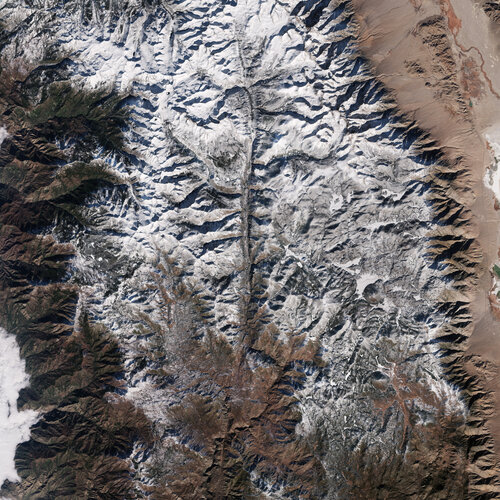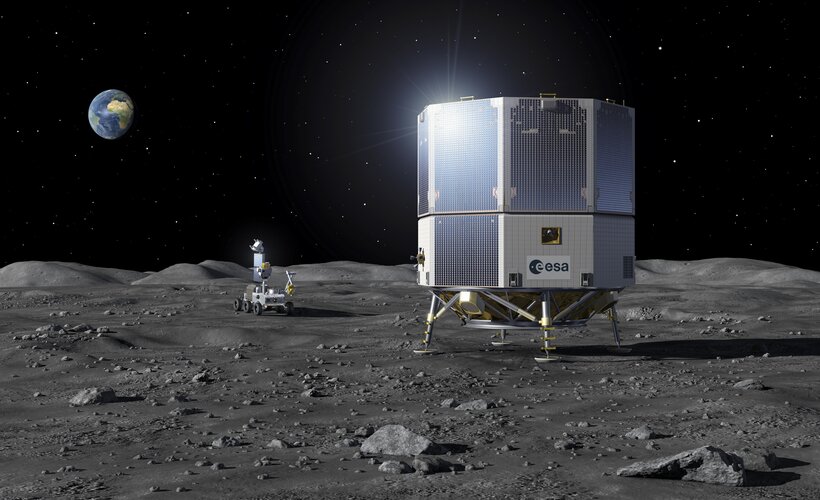Earth from Space: Land of giants
Friday, 21 March 2025 08:00 Image:
The Copernicus Sentinel-2 mission takes us over the Sequoia and Kings Canyon National Parks in California’s Sierra Nevada mountains.
Image:
The Copernicus Sentinel-2 mission takes us over the Sequoia and Kings Canyon National Parks in California’s Sierra Nevada mountains. French VLEO 5G startup strikes telecoms infrastructure partnership
Thursday, 20 March 2025 21:25
French satellite broadband startup CTO has teamed up with TDF, which operates France’s largest network of carrier-neutral hosting sites, to help integrate its proposed VLEO 5G services with terrestrial telcos.
U.S. Space Force budget trimmed in full-year continuing resolution
Thursday, 20 March 2025 20:23
The U.S. Space Force will operate with $28.7 billion in funding for fiscal year 2025, $800 million less than its requested budget of $29.5 billion
Hubble sees a spiral and a star in the constellation Virgo
Thursday, 20 March 2025 19:36This request seems a bit unusual, so we need to confirm that you're human. Please press and hold the button until it turns completely green. Thank you for your cooperation!
Press and hold the button
If you believe this is an error, please contact our support team.
185.132.36.159 : 47258fc8-b1c2-4720-b48f-3f855bd0
Making the rules for the final frontier
Thursday, 20 March 2025 15:21
In this week's episode of Space Minds, Richard DalBello, Principal, RDB Space sits down with host David Ariosto.
332nd ESA Council: Media information session
Thursday, 20 March 2025 13:00 Video:
00:34:08
Video:
00:34:08
Watch the media information session in which ESA Director General Josef Aschbacher and ESA Council Chair Renato Krpoun (CH) update journalists on the key decisions from the ESA Council meeting, held at ESA Headquarters in Paris on 19 and 20 March 2025.
Read ESA's Strategy 2040
Thursday, 20 March 2025 12:00
ESA's Strategy 2040
Read the Five Goals
ESA and JAXA strengthen ties on Moon and Mars exploration
Thursday, 20 March 2025 12:00
The European Space Agency's (ESA) Director of Human and Robotic Exploration, Daniel Neuenschwander, and the Japan Aerospace Exploration Agency's (JAXA) Vice President for Exploration and Human Spaceflight, Mayumi Matsuura, have signed a new statement of intent focused on Moon and Mars activities. This statement marks their intention towards a step forward in space exploration cooperation between ESA and JAXA, and lays the groundwork for expanded collaboration between the two agencies in advancing science, technology and international partnerships.
Spaceo leads ESA project to deploy inflatable sail for satellite disposal
Thursday, 20 March 2025 11:20 A European initiative spearheaded by Portuguese start-up Spaceo has secured a European Space Agency (ESA) contract to create a novel solution for clearing obsolete satellites and debris from orbit.
The program, called SWIFT (Spacecraft With Inflatable Termination), has received euro 3 million in funding to develop a deployable sail-like structure that acts as a drag device to hasten the d
A European initiative spearheaded by Portuguese start-up Spaceo has secured a European Space Agency (ESA) contract to create a novel solution for clearing obsolete satellites and debris from orbit.
The program, called SWIFT (Spacecraft With Inflatable Termination), has received euro 3 million in funding to develop a deployable sail-like structure that acts as a drag device to hasten the d How Altegrio is Redefining AI Development Services
Thursday, 20 March 2025 11:20 AI is one of the most popular and controversial topics discussed today, not only in tech-focused media. We decided to find out what running an AI development company is like today. To do this, we interviewed Oleg Goncharenko, a man who has been in charge of such a business for almost 15 years. Oleg himself is an entrepreneur with over 25 years of business experience, 15 of them in tech businesse
AI is one of the most popular and controversial topics discussed today, not only in tech-focused media. We decided to find out what running an AI development company is like today. To do this, we interviewed Oleg Goncharenko, a man who has been in charge of such a business for almost 15 years. Oleg himself is an entrepreneur with over 25 years of business experience, 15 of them in tech businesse Beyond expectations SKA-Low unveils its first cosmic snapshot
Thursday, 20 March 2025 11:20 The SKA Observatory has released the inaugural image from its Australian-based SKA-Low telescope, marking a pivotal moment in the project's journey to deliver an unprecedented view of the cosmos.
Captured using an early configuration of just 1,024 antennas out of a planned 131,072, this image offers a compelling preview of the discoveries that lie ahead for what is set to become the world'
The SKA Observatory has released the inaugural image from its Australian-based SKA-Low telescope, marking a pivotal moment in the project's journey to deliver an unprecedented view of the cosmos.
Captured using an early configuration of just 1,024 antennas out of a planned 131,072, this image offers a compelling preview of the discoveries that lie ahead for what is set to become the world' ESA's Euclid spacecraft unveils 'gold mine' of new scientific data
Thursday, 20 March 2025 11:20 The European Space Agency's spacecraft Euclid on Wednesday released a treasure trove of new data in its quest to map and unlock mysteries of what scientists call the "dark universe."
New data included deep-field space imagery and snapshots of thousands of different and distant galaxies that revealed the structure of the so-called "cosmic web." It also included survey of some 380,000 gal
The European Space Agency's spacecraft Euclid on Wednesday released a treasure trove of new data in its quest to map and unlock mysteries of what scientists call the "dark universe."
New data included deep-field space imagery and snapshots of thousands of different and distant galaxies that revealed the structure of the so-called "cosmic web." It also included survey of some 380,000 gal Chile reviews Chinese observatory plans slammed by US
Thursday, 20 March 2025 11:20 Chile said Wednesday it was reviewing an agreement for the construction of a Chinese astronomical observatory on its soil, a project that has drawn criticism from Washington as it jostles with Beijing for influence in Latin America.
Under an agreement signed by President Xi Jinping in 2016 with Chile's Catholic University of the North (UCN), the Ventarrones Astronomical Park was to be built
Chile said Wednesday it was reviewing an agreement for the construction of a Chinese astronomical observatory on its soil, a project that has drawn criticism from Washington as it jostles with Beijing for influence in Latin America.
Under an agreement signed by President Xi Jinping in 2016 with Chile's Catholic University of the North (UCN), the Ventarrones Astronomical Park was to be built Cosmic ray research accelerated by machine learning insights
Thursday, 20 March 2025 11:20 The complexity of artificial intelligence (AI), particularly neural networks modeled on the human brain, often sparks apprehension due to their opaque nature. While the societal implications of such systems vary by context, Dr. Jonas Glombitza of the Erlangen Center for Astroparticle Physics (ECAP) at Friedrich-Alexander Universitat Erlangen-Nurnberg (FAU) underscores a unique contrast. He notes
The complexity of artificial intelligence (AI), particularly neural networks modeled on the human brain, often sparks apprehension due to their opaque nature. While the societal implications of such systems vary by context, Dr. Jonas Glombitza of the Erlangen Center for Astroparticle Physics (ECAP) at Friedrich-Alexander Universitat Erlangen-Nurnberg (FAU) underscores a unique contrast. He notes DESI opens access to the largest 3D map of the universe yet
Thursday, 20 March 2025 11:20 The Dark Energy Spectroscopic Instrument (DESI) is mapping millions of celestial objects to better understand dark energy: the mysterious driver of our universe's accelerating expansion. This week, the DESI collaboration released a new collection of data for anyone in the world to investigate. The dataset is the largest of its kind, with information on 18.7 million objects: roughly 4 million sta
The Dark Energy Spectroscopic Instrument (DESI) is mapping millions of celestial objects to better understand dark energy: the mysterious driver of our universe's accelerating expansion. This week, the DESI collaboration released a new collection of data for anyone in the world to investigate. The dataset is the largest of its kind, with information on 18.7 million objects: roughly 4 million sta 